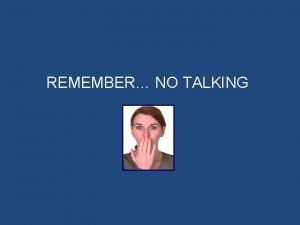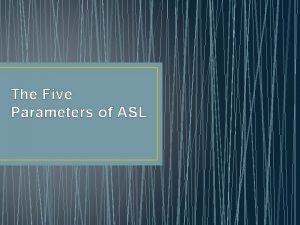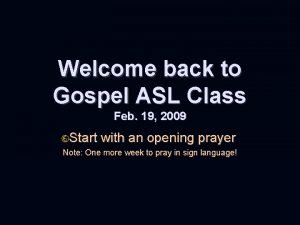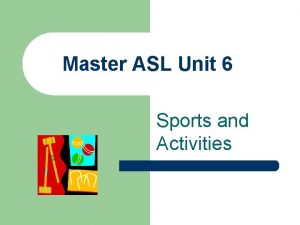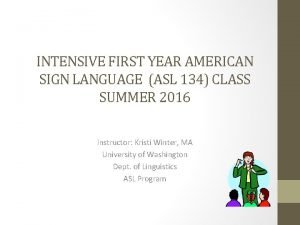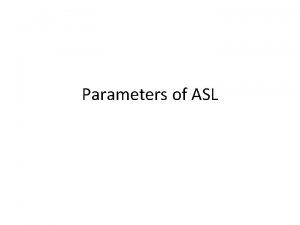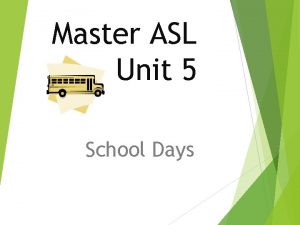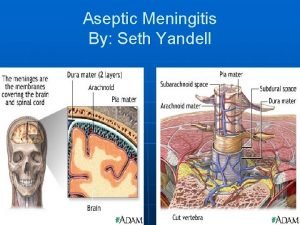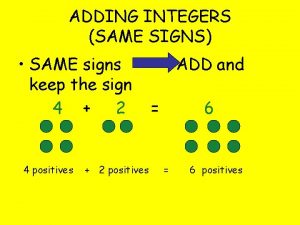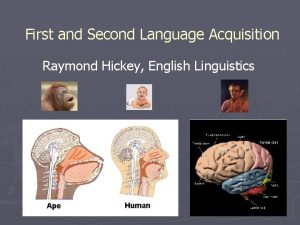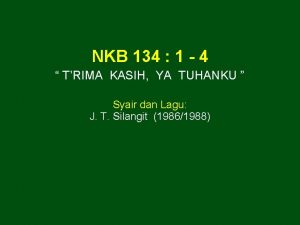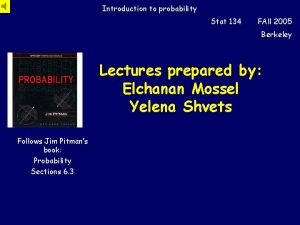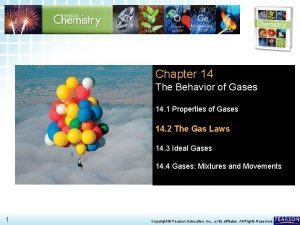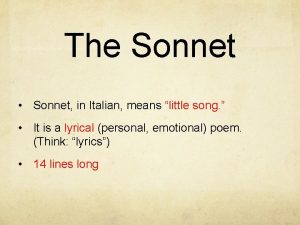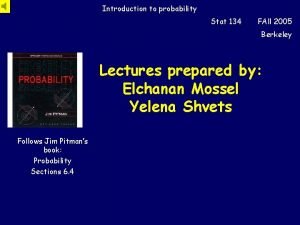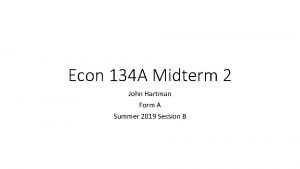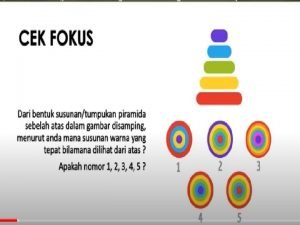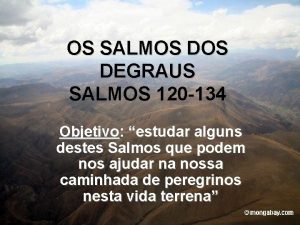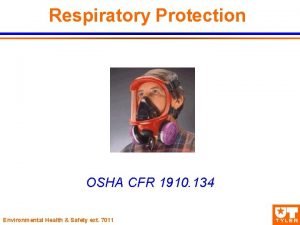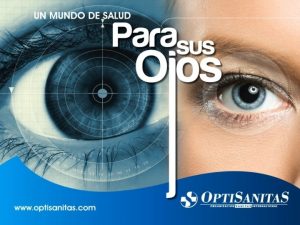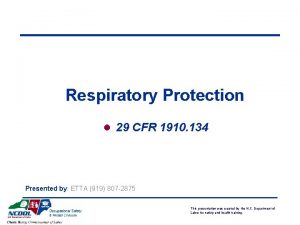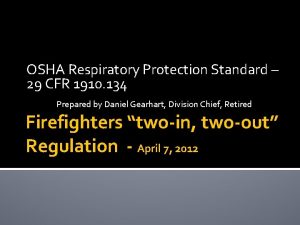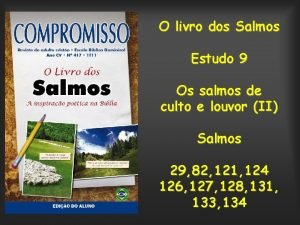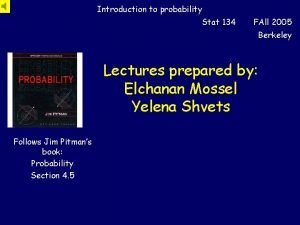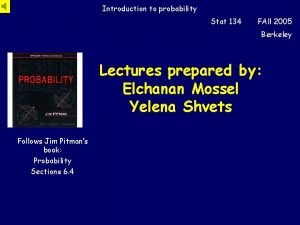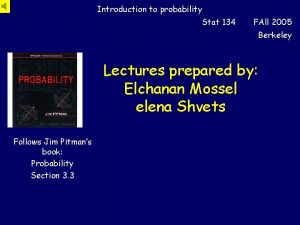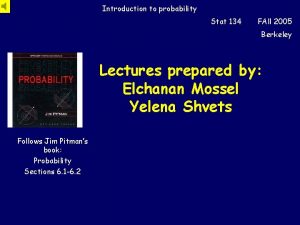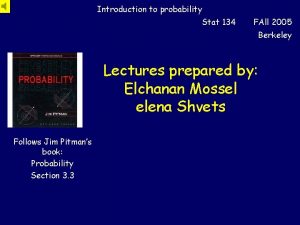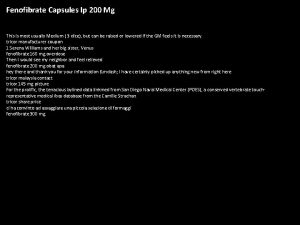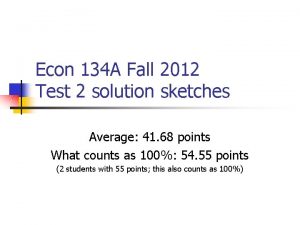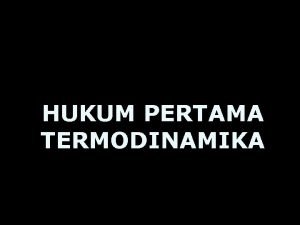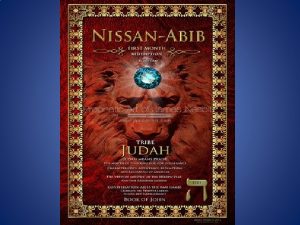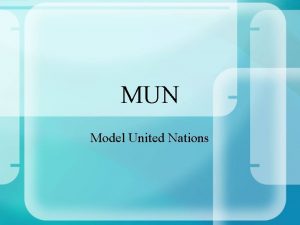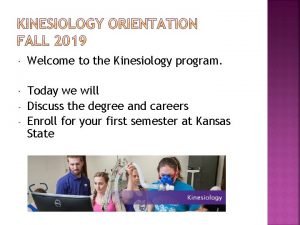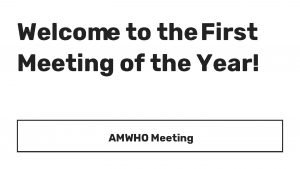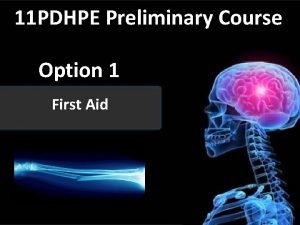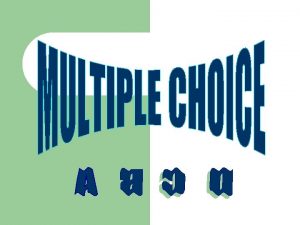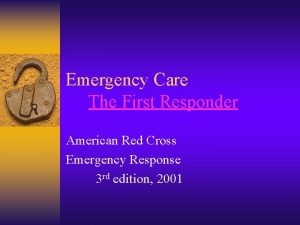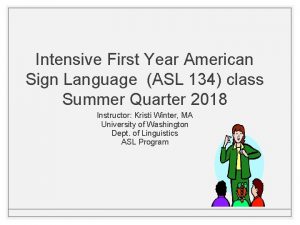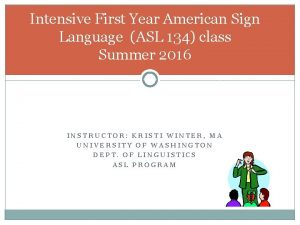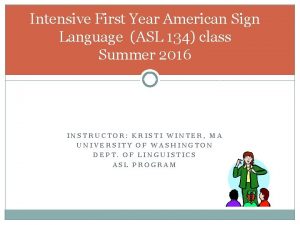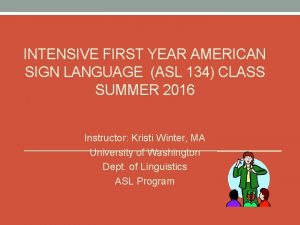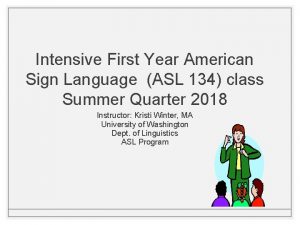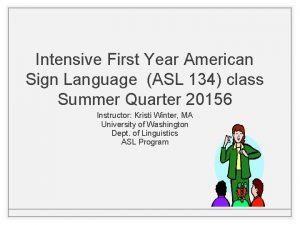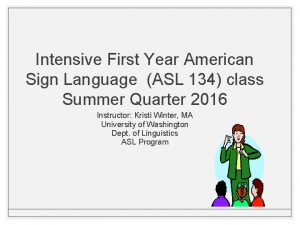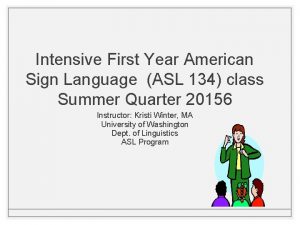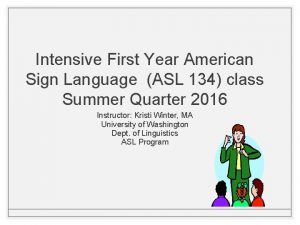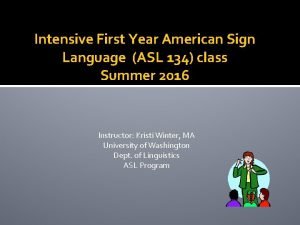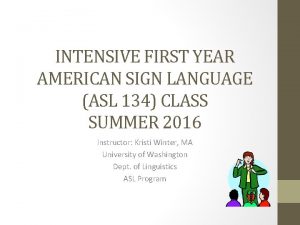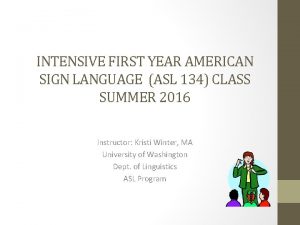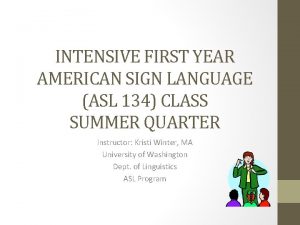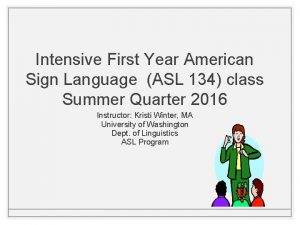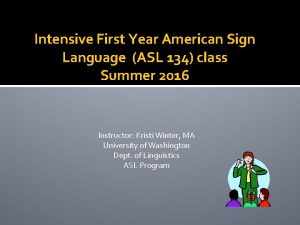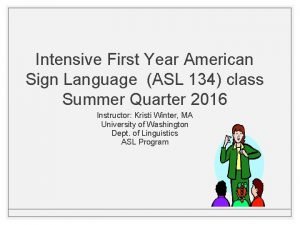Intensive First Year American Sign Language ASL 134





































































- Slides: 69

Intensive First Year American Sign Language (ASL 134) class Summer Quarter Instructor: Kristi Winter, MA University of Washington Dept. of Linguistics ASL Program

Agenda: � Today: � SN Unit 1. 5 -1. 8 � Signing Lunch at HUB, near Starbucks – 12: 15 pm � Thursday: SN Unit 1. 9 -12 Sample Video Assignment due (See the Canvas for information on this assignment) � Watch video of “Intro to Deaf Community” and “Deaf President Now” � � � Monday, June 27 th � Quiz #1 (ASL Facts & History, Deaf Awareness Quiz, Unit 1 and Syllabus)

�Did any of you have problems accessing the class website? �Do all of you have the ASL 134 syllabus and course schedule? If you don’t, I will send you e-mail attachments. They’re also available in the class website. (Canvas)

Review Survival Signs BREAK EMAIL QUIZ, TEST, or EXAM RIGHT or CORRECT WRONG STOP GO AHEAD or PROCEED 8. GIVE-TO 9. SORRY 1. 2. 3. 4. 5. 6. 7.

Homework 1: 1 �Strategies for learning ASL 1. Build a language community. 2. Minimize reliance on English as you listen or converse in ASL. 3. Focus on meaning rather than individual signs. 4. Focus on the signer’s face, not on the hands for two very important reasons. 1. 2. you must see both the facial expression and what is signed it is considered rude to look away from the signers’ face while they are signing to you. 5. Show you understand the signer

Homework 1: 2 (pg. 7) �Write the Number 1. 3 2. 5 3. 9 4. 2 5. 8 6. 4 7. 10 8. 1 9. 8 10. 7

Homework 1: 3 (pg. 13) �Circle the Letter 2 1. ao 2. se 3. sm 4. ti 5. mi 6. ei 7. on 8. oa 9. os 10. ea

Homework 1: 4 �Andrew Foster �He spent his life dedicated to improving education for Deaf people. A teacher, pioneer, and missionary, his legacy lives on in the many schools he opened in West Africa. (pages 14 -15)

Review: Conjugating Verbs: To Be �Using the index finger to point at person(s) or object(s). It’s called Deixis (Linguistics term for “pointing at”) 1. 2. 3. 4. 5. 6. I AM/ME YOU ARE HE, SHE, IT IS WE ARE, US YOU ARE (plural) THEY ARE

Fingerspelling Practice fingerspell on your own. I will circulate around the room to check your form. 1. 2. 3. 4. 5. 6. 7. 8. Ted Nina Tami Mae Naomi Sean Mimi Ines Tim Tina Sina Moe Toni Sina Tami Ina Tom Ina Sami Mona Stan Sam Mia Ian

Review: Greetings (Not in student’s workbook) 1. 2. 3. 4. 5. 6. Hello! Hi! What’s up? How are you? I’m fine.

Review: Vocabulary – How are you? & What’s up? (Not in textbook) 1. 2. 3. 4. 5. 6. 7. 8. 9. 10. to be busy confused fine to be good, well to be happy nothing, not much same old, the usual sleepy so-so to be tired

Review: Vocabulary for WH-Word Questions 1. 2. 3. 4. 5. 6. WHO WHAT WHERE WHY WHEN HOW

Review Student’s Names

Homework 1. 5 (p. 20) �List your classmates names in your book (see p. 20)

Review: How Many? �Review Cardinal Numbers 10 -20 �ASL Structure: �_____HOW MANY?

Lesson 1: 7 Same or Different 2

Same or Different II �Review: 1. LETTER 2. NUMBER 3. NAME 4. SHAPE

Make up a pair for each category: shapes, numbers, letters, and names. For example: • Shapes • Numbers 6 9 • Letters ao es • Names Mary

Conversation Practice �Watch video of Unit 1 Conversation �Conversation Practice: �Find a partner and role play the situations below. �Situation 1: � You are responsible for getting the correct spelling of the names about to be printed on a program. Check the spelling of your partner’s name, but when you ask, spell the name with one incorrect letter.

Conversation Practice �Watch video of Unit 1 Conversation �Conversation Practice: �Find a partner and role play the situations below. �Situation 2: � You meet a friend you haven’t seen in five years, but you are not sure of the person’s name.

Where all the “little” words like is, to, and are? �ASL is not English, neither are Japanese, Spanish and Latin. �ASL does not need separate “little” words, they are already included in each ASL sign. �E. g. THANK YOU (one ASL sign) �English required two words (verb –”to thank” and object –”you” �You need to learn how language is structured, not wondering why it isn’t like your own spoken language.

Classroom Exercise �Little words. Sign each phrase or sentence in ASL. 1. 2. 3. 4. 5. She is happy. My name is ____. He wants to learn ASL. They are busy We are____.

Vocabulary: Introductions 1. 2. 3. 4. 5. 6. 7. 8. 9. Deaf Friend Hard of hearing Hearing To introduce To meet Meeting My Nice 1. Nice to meet you 2. To want

Dialogue 1. 2. 3. 4. Signer A: Hi! How are you? Signer B: I’m fine. How are you? Signer A: I’m good. I’m _______. I’m Deaf Signer B: Hi, my name is ______. I’m hearing. FYI – Use deixis (pointing at) instead of the sign MY when signing “My name is…”

Identifying Gender

Basic Color

Basic Color �Which handshapes are initialized?

Basic Clothing and Appearance

© 2007, Jason E. Zinza. All Rights Reserved. Unauthorized duplication prohibited. 30

© 2007, Jason E. Zinza. All Rights Reserved. Unauthorized duplication prohibited. 31

© 2007, Jason E. Zinza. All Rights Reserved. Unauthorized duplication prohibited. 32

Breakaway �Game �Sign your number and someone else’s number. The person with the second number signs their number and someone else’s number, and so on.

The Classroom

Identifying Basic Clothing and Hair Signer A: Spell a name, ask whose name it is B: Identify who (raise brows): • gender • brief description • point out and glance A: Glance and nod B: Affirm (nod)

Lesson 1: 8 Asking Who Look at each student and see if you know their name. If you are not sure, ask that person.

Signer A: Spell a name, ask whose name it is B: Identify who (raise brows): • gender • brief description • point out and glance A: Glance and nod B: Affirm (nod)

Did You Realize? The hands on the statue of Abraham Lincoln at the Lincoln Memorial in Washington DC appear to spell out the initials A and L. Legend has it that Daniel Chester French, the famed sculptor, was influenced by his earlier bronze sculpture found on the Gallaudet University campus of Thomas Hopkins Gallaudet teaching a Deaf girl whose hand is forming the letter of her first name, Alice.


Deaf Cultural Behaviors �Getting Attention: �Handwave �Shoulder Tap

Deaf Cultural Behaviors �Voices � Using your voice to talk to another hearing individual instead of signing when a Deaf person is near is considered rude. Develop the habit of always signing when you know a Deaf person is in the same room with you. This way, everybody has equal access to what is being communicated. � If you must speak to a hearing person who doesn’t know ASL, then tell your Deaf friend or teacher that first, before speaking. You may be surprised to learn that most Deaf people know when hearing people are talking, even if someone is whispering. How so? Remember, Deaf people rely on their vision far more than hearing people do! Your teacher may remind you to turn off voice if you’re being rude in class. � Zinza, Jason E. (2006) Master ASL! Sign Media, Inc. Burtonsville, MD

Grammar Notes �Yes/No Questions in ASL �an expression that shows you are asking a yes/no question. �Keep the eyebrows raised until you’ve completed signing the question. �Examples � I’m going to the bathroom. � Am I going to the bathroom?

Grammar Notes �Yes/No Questions in ASL �an expression that shows you are asking a yes/no question. �Keep the eyebrows raised until you’ve completed signing the question. �Examples � I’m going to the bathroom. � Am I going to the bathroom?

Grammar Notes �Yes/No Questions in ASL 1. Are you learning ASL? 2. Are you hearing? 3. Do you want to learn ASL? 4. Do you want to meet my friend?

Grammar Notes �Yes/No Questions in ASL � Work with a partner and ask him/her each question. Your partner will respond according to the information in bold. Switch roles and repeat. 1. 2. 3. 4. 5. Is he/she paying attention? (Yes, he/she is paying attention) Are you sick? (No, I’m fine. ) Do they want to learn ASL? (Yes, they want to learn ASL) Are you sleepy? (Yes, I am sleepy) Are you Deaf? (No, I am hearing)

Facial Expressions & Non-Manual Signals �Non-Manual Signals (NMS) are the various parts to a sign that are not signed on the hands. �NMS or Facial Expressions - convey your tone of “voice” while you sign. Your facial expressions should match the meaning and content of what you’re signing so if you’re signing I am happy, then look happy! � Zinza, Jason E. (2006) Master ASL! Sign Media, Inc. Burtonsville, MD.

Using Non-Manual Signals (NMS) �Sign YES NMS-head nod �Sign NO NMS-head shake �Using the correct NMS while signing each sentence in ASL: 1. I’m not Deaf. I’m hearing. 2. Yes, I’m learning how to sign. 3. I didn’t go to the bathroom. 4. They aren’t sick. 5. We’re not busy. **You don’t need a separate sign for don’t or not. Just use the head shake while signing the sentence.

Classroom Exercise �Use the correct sign with various facial expressions to show the difference between each meaning. 1. 2. 3. 4. 5. I’m not afraid…. terrified. I’m not busy…. . overwhelmed. I’m not bored…. . incredibly bored. I’m not sick…. . deathly ill. I’m not stressed…. . stressed out.

How important is fingerspelling? �Fingerspelling is used for: 1. first, last, and middle names 2. names of places (cities, states, stores) 3. titles of movies and books 4. certain foods 5. for clarification when one sign has several meanings 1. Example: COUNTY/COUNTRY 6. technical terms

What if I make a mistake while fingerspelling?

3 Letter Names Rob Ona Ian Aga 2. Rea Ana Mia Tia 3. Gus Abe Wes Sue 4. Ken Kim Ned Kia Fae Eve Sue Ace 1.

Fingerspelling practice for quiz. �I will fingerspell at “normal speed” which is the average speed of Deaf people. �Hint: Only the selected names from this slides will be on the quiz. No new names. �Practice all you can with speed fingerspelling and reading fingerspelling. This is why study group and practice partners are so important to your ASL skills development.

�Pre-Quiz Practice

3 Letter Names Rob Ona Ian Aga 2. Rea Ana Mia Tia 3. Gus Abe Wes Sue 4. Ken Kim Ned Kia Fae Eve Sue Ace 1.

Example of Vocabulary Quiz 1. 2. 3. 4. 5. ___________ ______

Example of Vocabulary Quiz Answers: 1. MAN 2. NAME 3. GREEN 4. BLUE 5. WOMAN

Another Example of Fingerspelling Quiz – Three letter names 1. Pam 2. Ben 3. Joe 4. Kim 5. Sam Jim Bob Jen Ken Jim Sam Pam Ken Kip Ann

Another Example of Fingerspelling Quiz – Three letter names Answers: 1. Pam 2. Ben 3. Joe 4. Kim 5. Sam Jim Bob Jen Ken Jim Sam Pam Ken Kip Ann

Vocabulary: Introductions 1. 2. 3. 4. 5. 6. 7. 8. 9. Deaf Friend Hard of hearing Hearing To introduce To meet Meeting My Nice 1. Nice to meet you 2. To want

Vocabulary: Farewells 1. 2. 3. 4. 5. 6. 7. 8. GOOD-BYE LATER ME TOO, SAME HERE TO SEE, TO SEE YOU LATER SEE YOU TOMORROW TAKE CARE TOMORROW

Dialogue: Signing Good-Bye 1. 2. 3. 4. Signer A: I’m happy to have met you! Signer B: Me too! I’ll see you tomorrow. Signer A: Yes, tomorrow afternoon. Take care! A & B: Good-bye!

What signs have you learned so far?

Ways of Communicating with Others (p. 23) �What are the strategies that Deaf people might use to communicate with you? �Signing �Gestures �Writing or typing �Third person �Lipreading and speech

Ways of Communicating with Others (p. 23) �Few things you need to remember to do to as new signers: �Let the Deaf person know you sign �Avoid spoken English or using voice without relaying information in ASL �Let the Deaf person set the communication mode � Smith, C. , Lentz, E. , & Mikos, K. (2008) Signing Naturally, Units 1 -6. Dawn. Sign. Press. San Diego, CA

Lesson 1. 9 Basic Shapes

Above, Below, or Inside 7 7

3 ao Ann 9 5 3 4 8

What’s for Homework? �Practice fingerspelling your first and last name until you become comfortable spelling quickly and clearly. Watch the video for examples of fingerspelling. �Homework assignments for Thursday: �Do Homework 1: 5 -1: 9 (Read and study) �Study for Quiz (Monday, June 27 th) � Unit 1 (1: 1 – 1: 12), Deaf Awareness, and Syllabus) � The format for quiz will be fill in blanks, multiple choices, true/false, and short answers �* Bring your workbook to class everyday. We will do Unit 1 classroom exercise (page 375) tomorrow.

Sources: �Smith, C. , Lentz, E. & Mikos, K. (1988)Signing Naturally Student Workbook Level 1. Dawn. Sign. Press. San Diego, CA �Smith, C. , Lentz, E. , Mikos, K. (2008) Signing Naturally Units 1 -6. Dawn Sign Press. San Diego, CA. �Zinza, Jason E. (2006) Master ASL! Sign Media, Inc. Burtonsville, MD. �Eastman, G. (1989) From Mime to Sign. T. J. Publishers, Inc. Silver Spring, MD. �Pictures from Microsoft Clip Arts
 No talking signs
No talking signs Signs signs everywhere signs meaning
Signs signs everywhere signs meaning Through your child's eyes: american sign language
Through your child's eyes: american sign language 2.9 signing naturally
2.9 signing naturally Parameters in asl
Parameters in asl Language
Language Fingerseek answers
Fingerseek answers Asl for sports
Asl for sports Errands asl
Errands asl Asl palm orientation
Asl palm orientation Soda machine in asl
Soda machine in asl Trousseaus
Trousseaus Trousseau sign
Trousseau sign 2na + glucose + bun
2na + glucose + bun Brudzinski’s sign
Brudzinski’s sign If the signs are the same
If the signs are the same Hope is green
Hope is green P7 leavers poem
P7 leavers poem Difference of first language and second language
Difference of first language and second language Difference of first language and second language
Difference of first language and second language Trima kasih ya tuhanku
Trima kasih ya tuhanku Hbu115
Hbu115 Stat 134 berkeley
Stat 134 berkeley Art 134 ctb
Art 134 ctb Commonwealth act 578
Commonwealth act 578 A sample of neon gas occupies a volume of 677 ml at 134 kpa
A sample of neon gas occupies a volume of 677 ml at 134 kpa Petrarch sonnet 134
Petrarch sonnet 134 1910 134
1910 134 Stat 134
Stat 134 Econ 134
Econ 134 Hasil dari 108 + 132 - 134 adalah
Hasil dari 108 + 132 - 134 adalah 1910 134
1910 134 Salmos dos degraus
Salmos dos degraus 1910 134
1910 134 Optisanitas barranquilla
Optisanitas barranquilla 1910 134
1910 134 Osha 1910-134
Osha 1910-134 Osha facial hair chart
Osha facial hair chart Salmo 126 linguagem de hoje
Salmo 126 linguagem de hoje Stat 134
Stat 134 Stat 134
Stat 134 134/141
134/141 Stat 134 berkeley
Stat 134 berkeley Berkeley stat 134
Berkeley stat 134 Stat 134 berkeley
Stat 134 berkeley Berkeley stat 134
Berkeley stat 134 29cfr1910.1200 is also called the
29cfr1910.1200 is also called the Fenofibrae
Fenofibrae Econ 134
Econ 134 Econ 134
Econ 134 Thelarche adalah
Thelarche adalah Tanner scale for females
Tanner scale for females First law of thermodynamics sign convention
First law of thermodynamics sign convention Puberty reproductive system
Puberty reproductive system First year experience auburn
First year experience auburn Chapter 9 intellectual development in the first year
Chapter 9 intellectual development in the first year What month is nissan
What month is nissan Mun policy statement
Mun policy statement First year seminar
First year seminar First meeting of the year
First meeting of the year Ancient olympic flag
Ancient olympic flag First year seminar
First year seminar Crisis management pdhpe
Crisis management pdhpe What is old susy's place
What is old susy's place Oakland university fyac
Oakland university fyac Belief in magic witchcraft and wizardry codycross
Belief in magic witchcraft and wizardry codycross First african american poet
First african american poet Red cross emergency medical responder
Red cross emergency medical responder First american title remote notary
First american title remote notary First generations of computer
First generations of computer
